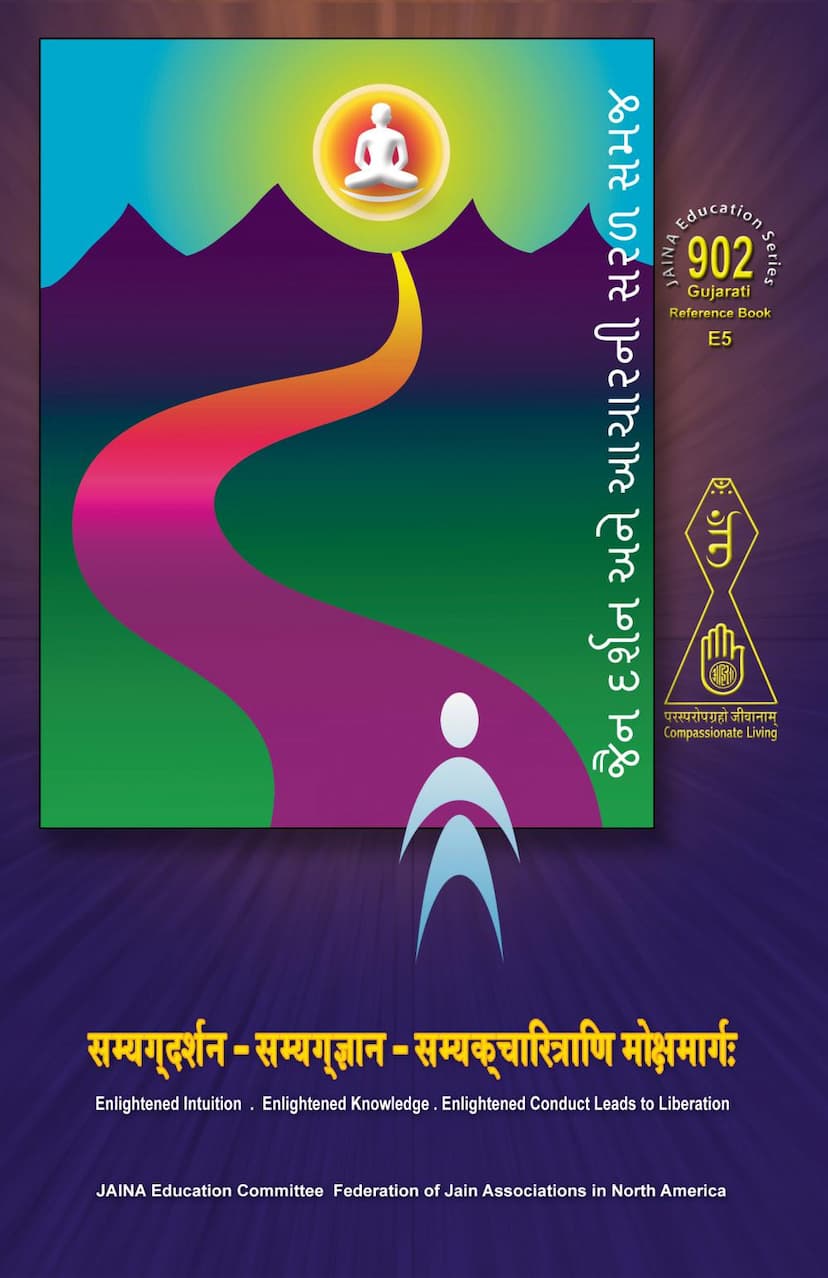JES902 Jain Darshan Ane Acharni Saral Samaj
Added to library: September 1, 2025

Summary
The provided text is the Gujarati translation of the book "Jain Darshan Ane Acharni Saral Samaj" (A Simple Understanding of Jain Philosophy and Conduct) by Pravin K. Shah, published by the JAINA Education Committee. It is part of the JAINA Education Series (JES 902). This summary covers the key aspects presented in the provided pages.
Overall Purpose: The book aims to provide a simple and accessible understanding of Jain philosophy and conduct for Gujarati speakers, particularly those in English-speaking countries where Jain literature might not be readily available. It serves as an educational resource for understanding the core tenets of Jainism.
Key Themes and Content:
- Core Jain Principles: The book highlights the foundational principles of Jainism:
- Ahimsa (Non-violence): The paramount principle, extending to all living beings.
- Anekantavada (Multi-perspectivism): The idea that truth is multifaceted and can be viewed from different perspectives.
- Aparigraha (Non-possession/Non-attachment): Limiting possessions and attachment to material things.
- Compassionate Living: The book emphasizes living a life of compassion, respect for all creatures, and mutual dependence among all living beings and plants. It advocates for veganism and a life free from alcohol and intoxicants as essential for a moral and virtuous lifestyle.
- The Path to Liberation (Moksha Marga): Jainism's ultimate goal is liberation. This is achieved through the "three jewels":
- Samyak Darshan (Right Faith/Enlightened Intuition): Correct perception and belief in the true nature of reality.
- Samyak Gyan (Right Knowledge/Enlightened Knowledge): Accurate and comprehensive understanding of the soul, matter, and the universe.
- Samyak Charitra (Right Conduct/Enlightened Conduct): Living a life of ethical behavior, adhering to vows and principles.
- Prayers and Mantras:
- Namokar Mantra (Namaskar Mahamangal Sutra): The central prayer in Jainism, revering the five supreme souls (Arihant, Siddha, Acharya, Upadhyaya, Sadhu). It is described as a powerful purifier of the soul and a source of spiritual knowledge.
- Four Sharan (Refuges): Seeking refuge in Arihants, Siddhas, Sadhus, and the Dharma taught by the Kevalis.
- Guru Gratitude Prayer: Expressing thanks to spiritual teachers.
- Universal Forgiveness Prayer (Kharemi Savvajjeve...): A prayer for universal forgiveness and friendliness.
- Universal Peace Prayer (Shivamastu Sarvajagat...): A prayer for the welfare of all beings.
- God and Tirthankaras: Jainism does not believe in a creator God. Instead, it reveres Tirthankaras (Jinas) who are enlightened beings who have attained liberation and shown the path to others. The book discusses the 24 Tirthankaras, with Lord Mahavir being the last of the current era. It clarifies the roles of Arihant, Kevali, and Siddha.
- Lord Mahavir: The book details the life of Lord Mahavir, his renunciation, his spiritual quest, his attainment of Kevala Jnana (omniscience), and his teachings. It highlights his emphasis on the five great vows (Maha-vratas) and his role in reforming and establishing the Jain monastic order (Sangh).
- Jain Philosophy (Tatva-gnan):
- Six Dravyas (Substances): The fundamental constituents of the universe: Jiva (soul), Pudgala (matter), Dharma (medium of motion), Adharma (medium of rest), Akash (space), and Kala (time).
- Nine Tattvas (Principles): The classification of reality, including Jiva, Ajiva, Asrava (influx of karma), Bandha (bondage of karma), Punya (merit), Papa (demerit), Samvara (cessation of karma), Nirjara (shedding of karma), and Moksha (liberation).
- Karma Theory: A detailed explanation of how karma binds the soul, the types of karma (Ghati and Aghati), and the process of karma bondage and its cessation.
- Gunasthana (Stages of Spiritual Development): The 14 progressive stages of spiritual evolution from delusion to liberation.
- Time Cycles (Kalachakra): The concept of ascending and descending time cycles (Utsarpini and Avasarpini) and their impact on human life.
- Jain Conduct (Achara):
- The Five Great Vows (Maha-vratas): For monks and nuns: Ahimsa, Satya, Asteya (non-stealing), Brahmacharya (celibacy), and Aparigraha.
- The Twelve Vows (Anu-vratas, Gunavratas, Shikshavratas): For householders (Shravakas and Shravikas), which are modified and lesser forms of the Maha-vratas, along with vows related to limiting consumption and donation.
- Six Essential Daily Duties (Avashyak Anushthana): Practiced by monks and nuns (with variations for laypeople).
- Yoga in Jainism: The book explains that yoga, in the Jain context, encompasses practices for controlling the mind, speech, and body to purify the soul and attain liberation. It discusses various paths like Bhakti Yoga, Jnana Yoga, Karma Yoga, and Ashtanga Yoga, highlighting their relevance within Jainism.
- Ethical Living: Emphasis on minimizing harm to all living beings, including microscopic ones, and respecting the environment. It discusses the concept of "least violence" for laypeople and a critical examination of the dairy industry from an Ahimsak perspective.
- Sati-sanskara/Sallekhana: The Jain practice of voluntary fasting and renunciation of life under specific spiritual and health conditions.
- Jain Sects: The major divisions of Jainism – Shvetambara (white-clad) and Digambara (sky-clad) – are discussed, along with their sub-sects and differences in practices, scriptures, and interpretations.
- Jain Scriptures (Agama Sutras): The book mentions the importance of the Agama Sutras as the foundational texts, originating from Lord Mahavir's teachings. It notes the differences in acceptance of these texts between the Shvetambara and Digambara traditions.
- Jain Symbols: The meaning behind key Jain symbols like the handprint (Ahimsa), the three dots (Ratnatrayi), the crescent moon (Siddhashila), the Swastika/Om, and the overall structure representing the universe (Lokakash) is explained.
- Jain Festivals: The book outlines major Jain festivals, often linked to the life events of the Tirthankaras, such as Paryushan, Mahavir Jayanti, Akshaya Tritiya, and Diwali (Mahavir Nirvana Day).
Publisher and Author: The book is published by the JAINA Education Committee (Federation of Jain Associations in North America) and authored by Pravin K. Shah. The Gujarati translation was done by Kumud Palkhiwala.
In essence, "Jain Darshan Ane Acharni Saral Samaj" serves as a comprehensive introduction to Jainism, covering its philosophical depth, ethical guidelines, spiritual practices, and historical context, presented in a clear and understandable manner for a Gujarati audience.